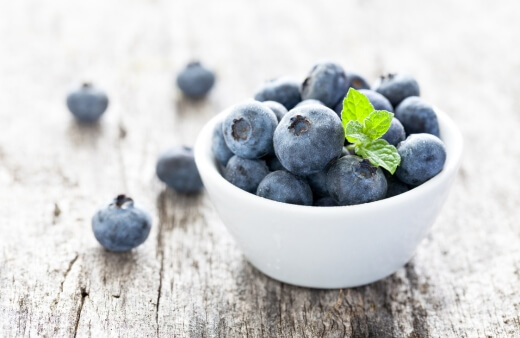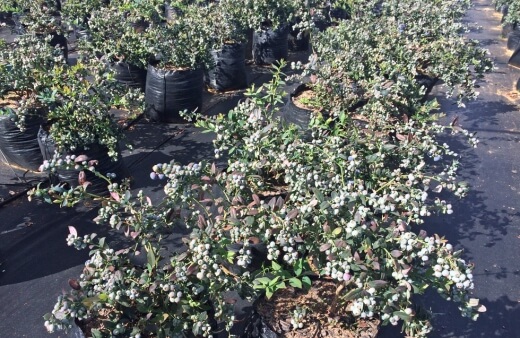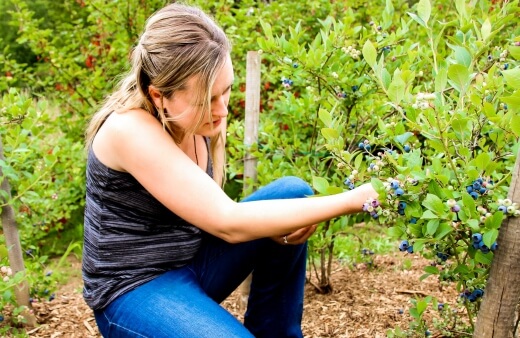With breakfast or as a snack, blueberries are a fantastic fruit packed full of natural nutrients. Now, even if you’re not accustomed to growing fruit at home, blueberries are a great place to start. With the right soil and a little bit of effort, blueberries are incredibly easy to grow.
Whether in a container or in your garden, our growth and care guide will give you everything you’ll need to know to cultivate, care for and grow this fantastic fruit.
More...
Introducing Blueberries

Blueberries are from the Vaccinium genus and are smaller-growing, fruit-producing plants. The small, deep-blue fruit are incredibly nutritious, filled with antioxidants, fibre and vitamins.
Interestingly, up until the 1900s, blueberries were only found in the wild, picked and used by indigenous cultures as a valuable food source. Although blueberry bushes take around ten years to reach full maturity, you can have a fruit-producing plant in as little as 2 to 3 years.
Types of Blueberries
There are four common varieties of blueberries you can choose to grow. Although some are better suited to certain climates, almost all varieties can be grown in Australia with the right care.
Highbush Blueberries
Highbush or Vaccinium corymbosum is a common, taller growing variety of blueberry bush. Often grown for its cold hardiness, fruit size and fruiting season. If you’re planning on growing highbush blueberries, consider types such as the ‘Bluecrop’, ‘Blueray’ or ‘Pink Lemonade’, which produces small, pink fruits.
Lowbush Blueberries
Lowbush or Vaccinium angustifolium is not suitable for growing in Australia
Rabbiteye
Rabbiteye or Vaccinium virgatum is a very adaptable and pest-tolerant variety of the blueberry bush. This cultivar produces a very high-quality crop. If planning on growing rabbiteye, consider varieties like ‘Emerald’, ‘Windsor’ or ‘Springhigh’.
How to Grow Blueberries in Australia
Whichever variety of blueberry you’re planning to grow, you’ll want to choose somewhere sunny with some slightly acidic soil. It’s also important to note that blueberries are very shallow-roots, and as such, need moist but well-draining soil.
Avoid growing your blueberries in clay soils unless the soil has been amended. Blueberry bushes also struggle to pollinate themselves, so it is advisable to grow at least two bushes in close vicinity to ensure that they pollinate and fruit.

Planting Blueberries
The best time of year to plant blueberries is during the spring or fall. If you live in a region that experiences particularly cold autumn, rather opt for mid-spring to allow your plants to establish properly before the first frost.
Ideally, choose 1 to 3-year-old plants from a reputable nursery as this will ensure you have fruiting bushes in no time.
When planting, here’s what you need to do:
- Pick a sunny spot. Blueberries need a sunny and sheltered spot to grow. Avoid growing your blue bushes too close to larger trees. Trees will draw a lot of the nutrients from the soil and may cast your bushes into the shade.
- Plant in a patch. To ensure your blueberry bushes pollinate, you’ll want to choose an allocated patch for them to grow, rather than scattering them around the garden.
- Amend the soil. It’s always a good idea to supplement your soil with some fresh organic matter to fill it with nutrients before planting. Blueberries also enjoy acidic soil, so it’s a good idea to check your soil pH before planting. A ph balance between 4 and 5 is ideal.
- Dig a hole. Dig a hole about 50 cm deep and 20 cm wide. You’ll want to ensure that the top of the root ball stays level with the soil.
- Space your bushes. Whether growing in a row or in a patch, you’ll want to space your plants around 1.2 to 1.5 metres apart.
Back-fill and pack. Backfill with fresh soil and gently pat down using your hands to remove any air pockets.
How to Care for Blueberries

Watering Needs
Blueberries require a regular watering routine, sufficient light and the occasional fertiliser to produce a bountiful harvest in the summer. Your blueberries will need around 2.5 to 5 cm of water per week. Take care not to overwater or waterlog the soil.
Fertilising Blueberries
A balanced, 10-10-10 fertiliser should be added to the soil annually during the spring. Avoid fertilising within the first month after planting, but continue to do so annually thereafter.
Regularly weed around the base of the plant. Alternatively, consider mulching around the base of your blueberry plant. As the blueberry plant has a shallow root system that likes moisture, mulching will also help to retain soil moisture.
Staking
Younger plants, especially when planting in the wind prone areas, may need staking for the first few years of growth. Avoid staking your blueberry plant for more than the first three years of growth. It is also a good idea to pinch back blossoms in the first few years to allow your blueberry plant to conserve energy for fruiting.
Your blueberry plant will also need to be protected from birds and frost. Birds love feeding on your fruit, so consider draping nets or creating a light cover for your blueberries (without affecting the level of sunlight). In winter, you may also want to consider covering your blueberries with some burlap to protect them from major frost and snow.
Pruning Blueberries
Pruning won’t be necessary for the first few years of growth. However, around the 4th year, it’s a good idea to start pruning your blueberry bush in late winter or early spring to promote new growth.
Using a sharp pair of pruning shears, simply remove any dead, broken, short, weak or damaged branches. Avoid letting your blueberry bush get overcrowded; the inner branches will need plenty of light to bear fruit.
Harvesting & Storing Blueberries

Wait a week after your blueberry fruits begin to turn blue. Harvesting too early will result in tart fruits. When perfectly ripe, the blueberry fruits should easily be picked by hand. Ideally, they should fall straight into your hand.
You can either enjoy your blueberries straight away, store them in your fridge for a week or two or consider storing them in your freezer. Blueberries are one of the most suited fruits for freezing and can be stored in the freezer for at least a year.
Blueberries can also be turned into a delicious jam or preserved.
Common Bluebbery Pests & Problems
Especially when grown in containers, blueberry plants aren’t likely to develop issues. The largest concern for most growers is the risk of having birds rob them of their long-awaited bounty.
Other common pests include the blueberry maggot. This can be controlled with regular maintenance or a natural pesticide. Avoid using anything with strong chemicals as this can affect your fruit and can make it dangerous to consume.
In some cases, blueberries can suffer from powdery mildew. Regular pruning will prevent the spread of mildew.
Blueberries Frequently Asked Questions

Can you grow blueberries in a container?
You definitely can! Blueberries grow fairly well in pots, and they are a great way to protect them from eager birds. Plus, it enables you to control the soil if your garden doesn’t offer a suitable option. Be sure to mulch around the base to keep the soil moisture level suitable.
The best varieties to grow in a pot include ‘Top Hat’, ‘Pink Lemonade’ and ‘Pink Champagne‘.
What are the benefits of blueberries?
Blueberries are high in vitamin C and apparently the pigment in the skin is a powerful antioxidant. Enjoying them as part of your normal diet will help protect you against cancer and heart disease and it has also been proven that they can protect you against vision loss.
How many blueberries are in one bush?
Depending on size and maturity, you should receive about 4-7 kg of fresh, delicious blueberries per harvest.
Do blueberries come back every year?
Once mature, your blueberry plants will produce fruit every year. Depending on the conditions, some varieties will even fruit twice a year.
Are coffee grounds good for blueberries?
Coffee grounds are a great way for you to boost your soil acidity. Plus, it’s an eco-friendly way to get rid of your waste while nurturing your plants.
For more guides to growing plants with plenty of health benefits, check out our list below:
Quick Blueberry Fun Facts
- Blueberries are one of the only foods that are naturally a deep blue colour.
- Blueberries are a well-known superfood that is a great source of minerals without too many calories or sugars.
- Certain cultures believe that a tea made from the dried leaves can be turned into that it supports good heart health.
- Dried and crushed blueberries are a fantastic addition as a crust to meats.
Are you feeling adventurous? Consider adding some other fruits and vegetables to the mix. We’ve got a range of growing guides for you to follow to guarantee success.

Start Growing Blueberries today!
Blueberries are an ideal place to start your fruit and veggie garden or to grow in isolation. Get ready to start growing today - be sure to prepare the soil and pick a perfectly sunny spot for your blueberries.
Published on April 15, 2023 by Maisie Blevins
Last Updated on January 28, 2024



